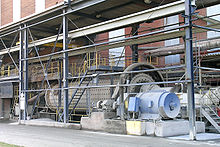Ball mill
The ball mill is a device for coarse, fine and ultra-fine size reduction or homogenization of ground material. It consists of a rotating grinding chamber in which the ground material is crushed by grinding media. The ball mills described here, in which balls are used to crush the ground material, are to be distinguished from stone mills .
classification
Ball mills belong to the group of grinding media mills and are primarily used for grinding. In terms of process engineering, they therefore belong to mechanical process engineering. Subspecies of the ball mills are
- steep mills: tumble mills,
- short mills: drum mills and
- long mills: tube mills .
Working principle
As with all grinding media mills, grinding media and grist are moved in the ball mill. This results in shocks between the grinding media and between the grinding media and walls. The grist is crushed when it is between the bodies. The comminution of the bodies / particles takes place through impact stress , so only materials with brittle fracture behavior are considered as regrind .
Balls or Cylpebs (cylinders) are used as grinding media . Ball mills are used for both wet and dry grinding. Different types of grinding media movement occur depending on the speed. At low speeds, a cascade movement takes place in which the balls only roll off. As the speed increases, the balls are raised and fall onto the grist ( cataract movement ). Above the critical speed, the balls are held by the centrifugal force on the drum wall and there is hardly any movement or grinding. The optimal operating point is above the onset of cataract movement and below the critical speed.
execution
Ball mills are usually constructed from a horizontally rotatably mounted circular cylindrical grinding jar. The grinding room is equipped with armor that can be changed. For cost reasons, cast iron balls are usually used as grinding balls , which do not even have to be round at the beginning of the grinding process. Balls made of steel , stone , porcelain or ceramic are also used on a laboratory scale .
The grinding chamber can be separated by one or more partition walls. The first chamber is then filled with the largest balls and the others with smaller balls. In cement mills, this separation is done continuously by means of a gate armor (separation of the balls by impulse on a beveled gate ). The mills are filled through a central opening in one of the end walls. The discharge depends on the design. In the case of dry mills, the ground material is discharged through slots in the pipe wall at the end of the mill. The grinding media are retained in this way.
Materials
Both the grinding bowl and the grinding balls can be made of different materials that should be as abrasion-resistant as possible . When grinding materials in the context of analysis , materials are chosen whose abrasion does not interfere with the analysis result. For example , if you want to measure the chromium content of a sample, you must not use steel grinding tools, as these contain chromium and would therefore change the chromium content of the sample.
Milling bowls and balls are now mostly made of chrome steel, tungsten carbide , ceramics, zirconium oxide , sintered corundum or agate ; in the past, flintstone was also used. Milling jars and balls should be made of the same material in order to minimize mutual wear.
However, for weight and cost reasons, mills made of sheet steel or even just a steel frame structure are now made with replaceable wear plates z. B. made of ceramic or rubber.
use
Generally, medium-hard to extremely hard, brittle and fibrous materials can be shredded. In addition, wet grinding and grinding under inert gas are possible with the appropriate aeration covers.
Plant engineering
Ball mills are used on a large scale as drum mills for comminuting clinker, ores, coal, etc. in mining , metallurgical engineering and the ceramics industry.
An example of the use of the ball mill can be found in the manufacture of enamel. (Or the frit required for enamelling , the ready-to-use enamel)
Laboratory equipment
In the laboratory, ball mills are mostly used to crush samples (see analytical chemistry ), for example in chemistry, metallurgy or in soil science . In biochemistry, ball mills are used to break down cells in bacteria, yeast or spores. Often, spheres made of glass or zircon are used.
See also
- Vibrating disc mill ; is used as part of the quality control of solids.
- Barrel finishing ; a machining process with a basically similar procedure
Web links
Individual evidence
- ^ Walter Wittenberger: Chemische Laboratoriumstechnik , Springer-Verlag, Vienna, New York, 7th edition, 1973, pp. 55–56, ISBN 3-211-81116-8 .
- ↑ Hansgeorg Hofmann and Jürgen Spindler : Process in coating and surface technology . Carl Hanser Verlag , 2nd edition, October 7, 2010, p. 171, ISBN 978-3-446-42378-7
- ↑ Kathy Barker: The Cold Spring Harbor Laboratory Manual for Beginners , Elsevier GmbH, Munich, 1st edition, 2006, p. 278. ISBN 978-3-8274-1656-8 .


